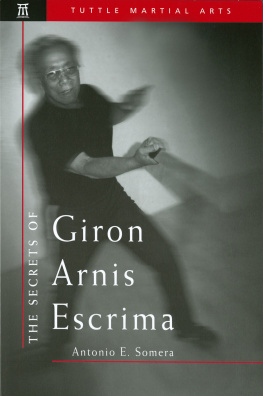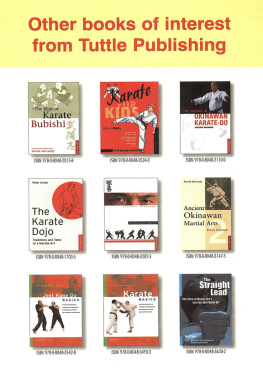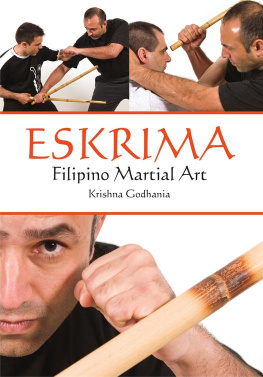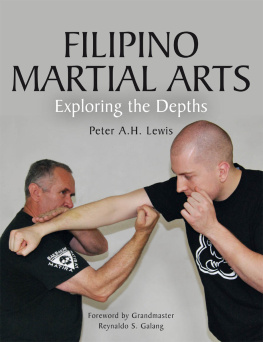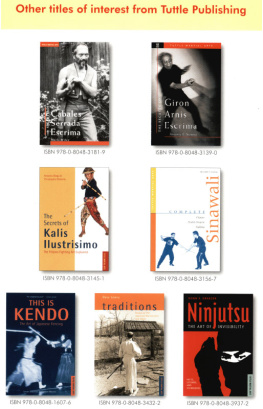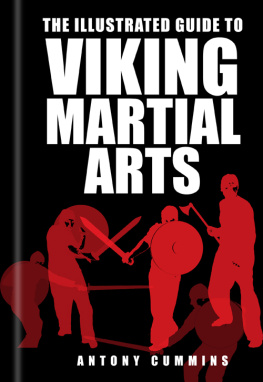Acknowledgments
I would like to thank Grandmaster Leo M. Giron who has shared his knowledge to so many of us and taught us not only the art of escrima but also the Filipino culture and history.
I would like to thank the following guros (teachers) who have helped Grandmaster Giron and myself to illustrate the art: Dexter Labonog (the head and senior instructor of the Bahala Na Club), Roy Atay, Dave Paler, Glenn Abresy, June Gotico, Barry Shreiarr, David Hines, Steve Tarani, and Jim Johnson.
I would like to thank Guro Dan and Paula Inosanto for all of their help and encouragement with this project and throughout the years.
I thank our photographer, Kim Rose, who at a moments notice drives all the way to Stockton to take our pictures, whether for this book or for any other Bahala Na function.
To Rob Farrens and the staff of the Stockton Athletic Club for allowing us at any time to use their wonderful facilities.
To Besar Pendakar Herman Suwanda for your guidance and support.
I thank the Bahala Na Martial Arts Association for keeping our art alive.
And, on behalf of Grandmaster Leo M. Giron and the staff of the Bahala Na Martial Arts Association, we extend our gratitude to Mark V. Wiley and Tuttle Publishing, whose books continue to set the standard of excellence.
Afterword
by Grandmaster Leo M. Giron
The information I pass on to my students during their time with me is limited to techniques of self-defense. It is the intention of the instructors at the various Bahala Na Filipino Martial Arts Academies not to teach this art beyond the scope of self-defense and sportsmanship. It is the duty of all instructors to shape the minds of their students to accept the art for the arts sake, and not for covert personal gains. It is imperative that the teacher instill the qualities of respect and integrity in the minds of his students during class. After they graduate from the academy, students may develop in such a way as to degrade the art, using it as a vehicle for destruction and violence. Should a negative use of the skills and knowledge I have entrusted in my students occur, their relationship with me is immediately severed.
Since I cannot be with the reader while he studies the skills and techniques of my art as described herein, I can only trust that he will never have to use this art unless it is absolutely necessary for the sake of self-defense. It is my wish that the reader and all students learn to use passive resistance. By realizing that because you have attained a level of proficiency in this art, it is you who has the upper hand in any confrontation, and must, therefore, be discrete in your ways. Seek to be friendly and gracious to all through the use of kind and tender words. Harshness in speech and mood only evokes negativity in others. Where there is trouble, there is no victor. If trouble should find you, and there are no other means of settling it, then be guided by the words inscribed on the sword of one of the famous knights of yesteryear:
No mu saquis sin rason,
No mi embaines sin honor
Draw me not without reason,
Sheath me not without honor.
My intention in writing this volume has been to introduce not only the solid foundation upon which Giron arnis escrima rests, but also a glimpse of the potential for the wide variety of stylistic and tactical responses included, but often hidden, in the complete system. This full creation is contained in what is called the fan of the master (el abanico del maestro), through the co-existence of twenty different, yet interrelated, styles and methods.
While this volume is not a substitute for training with a certified instructor, it is our sincere hope that this introduction may stimulate interest and appreciation for the art.
Bahala Na!
Table Of Contents
Published by Tuttle Publishing, an imprint of Periplus Editions (HK) Ltd. with editorial offices at 364 Innovation Drive, North Clarendon, VT 05759 USA.
Copyright 1998 by Antonio E. Somera
All rights reserved. No part of this publication may be reproduced or utilized in any form or by any means, electronic or mechanical, including photocopying, recording, or by any information storage and retrieval system, without prior written permission from the publisher.
Library of Congress Cataloging-in-Publication Data
Somera, Antonio E., 1957-
The Secrets of Giron Arnis Escrima / Antonio E. Somera.1st. ed.
xiii, 133p. : ill. ; 23cm.
ISBN 978-0-8048-3139-0 (pbk.)
ISBN 978-1-4629-1696-2 (ebook)
1. Giron, Leo M., 1911- . 2. Escrima. 3. Martial arts
Philippines. 4. Hand-to-hand fighting, Oriental. I. Title.
GV1114.38.565 1998
796.815dc21 97-45547
CIP
Distributed by:
North America,
Latin America & Europe
Tuttle Publishing
364 Innovation Drive
North Clarendon,
VT 05759-9436 USA
Tel: 1 (802) 773-8930
Fax: 1 (802) 773-6993
www.tuttlepublishing.com
Japan
Tuttle Publishing
Yaekari Building 3rd Floor
5-4-12 Osaki,
Shinagawa-ku,
Tokyo 141-0032
Tel: (81)3 5437-0171
Fax: (81)3 5437-0755
Asia-Pacific
Berkeley Books Pte Ltd
61 Tai Seng Avenue
#02-12, Singapore 534167
Singapore
Tel: (65) 280-3320
Fax: (65) 280-6290
www.periplus.com
First Edition
12 11 10 09 08 9 8 7 6 5
Printed in Singapore
TUTTLE PUBLISHING is a registered trademark of Tuttle Publishing, a division of Periplus Editions (HK) Ltd.
Dedication
In loving memory of my father,
Celestino Chester Serna Somera (1915-1995).

I would first like to dedicate this book to my loving and beloved wife, Sally, who has stood by me and has inspired me mentally and emotionally in my pursuit of the art I love so much. To my parents, Chester and Frances Somera, who raised me to believe in myself and to be proud of my Filipino heritage. My father, Chester, boarded the President Hayes in June of 1930, at the age of fifteen, to seek his fortune in a new land called America. My father is my strength. My mother, Frances (Dolly), married my father on April 1, 1954, and had to deal with the prejudices that went along with a culturally mixed marriage. She also worked along side my father for over forty years in the fields of Stockton, California. My mother is my love. To my brother, Chester Jr., who always protected me from the cruel actions of others while growing up as a mestizo. My sister, Felecitas (Felly), who also experienced the same cruel acts while growing up as a mestiza.
To my former karate teachers, Rodney Hu Sensei, Malcom Equinoa Sensei, and Eric Shingu Sensei, who without knowing it inspired me to pursue our Filipino art. To Dave Duckworth and Mel Won, who in my early years of education inspired me to be the best I could be.
I would also like to dedicate this book to all the past and present manongs and manangs that struggled and sacrificed in the early years to make our life better. To the past and present students of the Bahala Na Martial Arts Club for keeping our art alive. To uncle Carlos and Alberta, you are always in my thoughts and heart.
Last but not least, I would like to dedicate this book to Grandmaster Leo M. Giron, who has patiently taught me the art of my forefathers, who to many of his students is not only a wonderful person and an excellent teacher, but a great friend.

